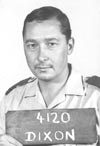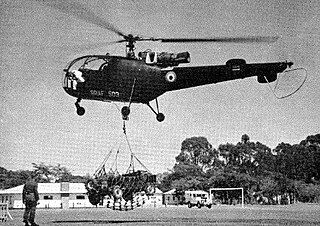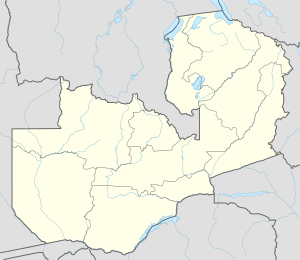
The Selous Scouts was a special forces unit of the Rhodesian Army that operated during the Rhodesian Bush War from 1973 until the reconstitution of the country as Zimbabwe in 1980. It was mainly responsible for infiltrating the black majority population of Rhodesia and collecting intelligence on insurgents so that they could be attacked by regular elements of the security forces. The unit did this by forming small teams that posed as insurgents and usually included captured insurgents. Over time, the Selous Scouts increasingly attacked insurgents themselves and operated in the countries that neighboured Rhodesia.

The Rhodesian Bush War, also called the Second Chimurenga as well as the Zimbabwean War of Liberation, was a civil conflict from July 1964 to December 1979 in the unrecognised country of Rhodesia.

Squadron Leader Christopher John Taylor Dixon D.C.D., also known by his callsign of Green Leader, was a Rhodesian military pilot for the Rhodesian Air Force and was born in Shabani, Southern Rhodesia. He was best known for leading the Rhodesian Operation Gatling bombing raid over Zambia, which later became known as the "Green Leader Raid".
Alick Nkhata (1922–1978) was a Zambian musician, freedom fighter and broadcaster from the 1950s to the mid-1970s. He was also the director of the Zambia National Broadcasting Corporation (ZNBC), and formed the Lusaka Radio Band, later called the Big Gold Six Band. The band played Zambian music and scored translations of original rural songs.

Air Rhodesia Flight 825 was a scheduled passenger flight that was shot down by the Zimbabwe People's Revolutionary Army (ZIPRA) on 3 September 1978, during the Rhodesian Bush War. The aircraft involved, a Vickers Viscount named the Hunyani, was flying the last leg of Air Rhodesia's regular scheduled service from Victoria Falls to the capital Salisbury, via the resort town of Kariba.

Air Rhodesia Flight 827, the Umniati, was a scheduled civilian flight between Kariba and Salisbury, Rhodesia that was shot down soon after takeoff on 12 February 1979 by Zimbabwe People's Revolutionary Army (ZIPRA) guerrillas using a Strela 2 missile. The circumstances were very similar to the shooting down of Air Rhodesia Flight 825 five months earlier. As of 2022 it remains the deadliest aviation incident in Rhodesia/Zimbabwe.

The 1st Battalion, The Rhodesian Light Infantry, commonly the Rhodesian Light Infantry, was originally formed in 1961 as a regiment of the army of the Federation of Rhodesia and Nyasaland. Raised as a light infantry unit at Brady Barracks, Bulawayo in Southern Rhodesia, the Regiment served in the Rhodesian Bush War as part of the Rhodesian Security Forces between 1964 and 1979, from 1965 under the unrecognised governments of Rhodesia and latterly, during the second half of 1979, Zimbabwe Rhodesia. The RLI remained active during an interim period under British control and then, from April 1980, within the armed forces of Zimbabwe, before disbanding on 31 October 1980.

The 1st Battalion, The Rhodesian Light Infantry, commonly the Rhodesian Light Infantry, served in the Rhodesian Bush War as part of the Rhodesian Security Forces between 1964 and 1979, under the unrecognised government of Rhodesia following its 1965 Unilateral Declaration of Independence from Britain. During the second half of 1979 it fought for Zimbabwe Rhodesia, a black majority-ruled version of the same state which also failed to win international recognition. After an interim period under British control from December 1979 to April 1980, the RLI briefly remained active within the armed forces of Zimbabwe, but did not see action under this government. It disbanded on 31 October 1980.
Operation Uric was a cross-border raid carried out in Mozambique by operatives of the Rhodesian Security Forces during the Rhodesian Bush War, with combat assistance from the South African Air Force. During the operation, which took place from 1 to 7 September 1979, up to 200 Rhodesian and South African military personnel attacked bridges and a major staging point for Zimbabwe African National Liberation Army (ZANLA) insurgents in Gaza Province. Along with Operation Miracle, this was one of the largest Rhodesian external operations of the war.
Operation Eland, also known as the Nyadzonya Raid, was a military operation carried out by the Rhodesian Selous Scouts at Nyadzonya in Mozambique on 9 August 1976. The Rhodesians initially claimed that 300 ZANLA and 30 FAM soldiers were killed, but later claimed that documentation captured after the event suggested that more than 1,028 were killed. ZANLA and Amnesty International claimed that the people killed were unarmed refugees.

Operation Miracle or the Battle of Mavonde was a military raid in 1979 by the Rhodesian Security Forces (RSF) against ZANLA guerrilla bases in Mozambique towards the end of the Rhodesian Bush War. ZANLA put up stiff resistance although at the cost of many losses with as many as Hundreds dead, The tactical success of the RSF did not lead to the expected strategic changes, But did result in a decisive tactical victory with few losses.
Operation Vanity was a Rhodesian military operation in Angola with clandestine assistance from the South African Air Force (SAAF) during the Rhodesian Bush War. The Rhodesian Air Force planned a retaliatory raid against a ZIPRA camp in Angola after a second Air Rhodesia Viscount was shot down on 12 February 1979.
Operation Placid was a Rhodesian military operation in Zambia with clandestine assistance from the South African Air Force (SAAF) during the Rhodesian Bush War. The Rhodesian Air Force planned raids against a ZIPRA camps in Zambia on the northern Rhodesian border.
Operation Motel was a Zimbabwe-Rhodesian military operation in Zambia with clandestine assistance from the South African Air Force (SAAF) during the Rhodesian Bush War. The Rhodesian Air Force planned raids against a ZIPRA camp in Northern Zambia.
Operation Snoopy was an operation launched by Rhodesia in response to Air Rhodesia Flight 825 being shot down by a communist backed insurgent group, the ZIPRA. The operation took place in Mozambique, where many of the ZANLA's camps were located, particularly in the area in and around Chimoio.
Operation Nickel or the Wankie Campaign or the Wankie Battles was a military operation launched by the Rhodesian Security Forces on 1 August 1967 in response to the group of ZIPRA and Umkhonto we Sizwe (MK) fighters crossing the Zambezi River, which marked the Rhodesian-Zambian border. The operation was a success with only one of the cadres out of a force of seventy-nine making it back to Zambia.
Operation Cauldron was launched by the Rhodesian Security Forces in response to an incursion by ZIPRA insurgents on 28 December 1967. Despite the death or capture of 77 out of 79 men, ZAPU, from its base in the Zambian capital, Lusaka, did not regard the incursion as a failure; on the contrary, its leaders were pleased that they had inflicted some casualties on the Rhodesian African Rifles. Buoyed by what they perceived as a success, they planned another operation to take place in northern Mashonaland: about 100 men—75 ZIPRA and 25 MK—were to infiltrate the Zambezi valley and establish a series of camps, including underground caches containing food, clothing, weapons and other equipment. They were instructed to avoid the Rhodesian Security Forces "at all cost" while they recruited local tribesmen to the nationalist cause and trained them. Once a sufficient indigenous force existed, they were to inform Lusaka, which would then coordinate a mass uprising. The aim was not to defeat the government forces, but rather to force the British military to intervene. If the operation were a success, the MK men were to be escorted to South Africa to begin similar activities.

Operation Griffin was a military operation launched by the Rhodesian Security Forces, on 16 July 1968, in response to an incursion into Rhodesia by communist insurgents belonging to the ZIPRA based in Zambia.
Operation Panga was a military operation launched by the Rhodesian Security Forces (RSF) against a camp belonging to the communist insurgent group, ZIPRA. The cadres camp was located on the Mushenshi River in Zambia.








